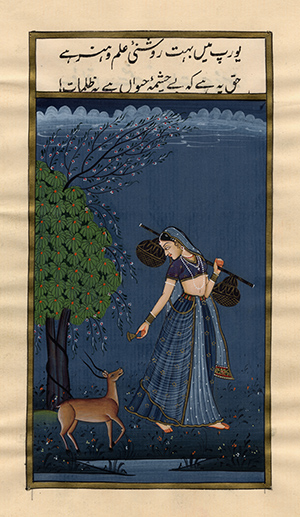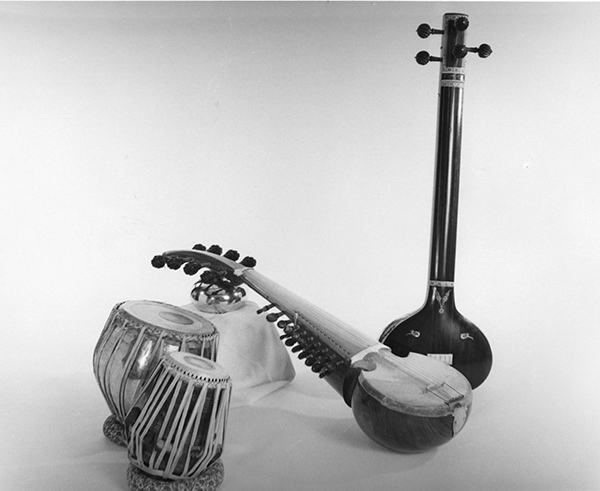 The classical tradition in Indian music dates back over 3,000 years to the Vedas, the earliest Hindu spiritual texts. The Sama Veda speaks of "Nada Bramha," the concept that "music is the language of God." Based on the fundamentals of Raga (melody) and Tala (rhythm) the music has developed continuously through ancient and medieval times into a system capable of expressing the finest shades and degrees of color and emotion. Indian classical music utilizes the same 12 note scale as is used in the West, except that the notes are used in just (pure) intonation rather than the equal temperament developed in Europe. The existence of "microtones" between the standard notes is also recognized.
The classical tradition in Indian music dates back over 3,000 years to the Vedas, the earliest Hindu spiritual texts. The Sama Veda speaks of "Nada Bramha," the concept that "music is the language of God." Based on the fundamentals of Raga (melody) and Tala (rhythm) the music has developed continuously through ancient and medieval times into a system capable of expressing the finest shades and degrees of color and emotion. Indian classical music utilizes the same 12 note scale as is used in the West, except that the notes are used in just (pure) intonation rather than the equal temperament developed in Europe. The existence of "microtones" between the standard notes is also recognized.
A raga is formed from a series of ascending and descending notes selected from a given music scale. Within this skeleton, the musician brings out the melody that gives a particular raga its character and mood: joy, sadness, romance, or a combination of these and other basic emotions.
In a classical performance, the raga is presented in two sections. In the first part, called alap , the musician plays unaccompanied and presents the notes contained within the raga, proceeding until all the notes and their interrelationship are explored. This allows the character of the notes and the raga to be shown in a framework free of a fixed rhythmic structure.
The second section, gat, is marked by the entrance of the accompanying table player. From this point the raga is presented within a rhythmic cycle, having a specified number of beats, called the tala. The most common cycles contain 16, 10, 7, or 6 beats, subdivided into blocks of 2,3, or 4 beats. The music takes the form of theme and variation with the tabla maintaining a fixed pattern while the instrumentalist solos, and improvising in turn when the instrumentalist returns to the initial theme. The interplay or musical exchange between the instrumentalist and the accompanying tabla player revolves around showing the sam, the downbeat of the cycle. The speed and energy of the exchange increases throughout the composition building to a climax at the end of the piece.
 The sarod evolved into a classical instrument about 150 years ago, an expression of the combination of the classical, court-based tradition of the Moghul Empire with instruments derived from the folk-based traditions of Central Asia. The body of the sarod is carved from a single piece of teak covered with a skin head. The steel fingerboard is fretless, permitting the use of the slides, ornaments, and microtones characteristic of Indian music. The brass bell at the end of the instrument acts as a resonator. The sarod has 25 strings, 18 of which are sympathetic. Four main playing strings produce the same note range as a viola. Three rhythm strings are tuned to the tonic note.
The sarod evolved into a classical instrument about 150 years ago, an expression of the combination of the classical, court-based tradition of the Moghul Empire with instruments derived from the folk-based traditions of Central Asia. The body of the sarod is carved from a single piece of teak covered with a skin head. The steel fingerboard is fretless, permitting the use of the slides, ornaments, and microtones characteristic of Indian music. The brass bell at the end of the instrument acts as a resonator. The sarod has 25 strings, 18 of which are sympathetic. Four main playing strings produce the same note range as a viola. Three rhythm strings are tuned to the tonic note.
The tabla is the classical drum of North India, used to accompany classical vocal or instrumental music since its development in the 18th century. It consists of two small hand drums, the right hand drum is made of rosewood, the larger left hand drum of copper or brass. Both are covered with heads made of multiple layers of goatskin. The black circle of paste and iron filings in the center permits the drum to be tuned precisely to a particular note. The drums, played separately and together, are capable of a wide variety of specific sounds or syllables which are combined into characteristic patterns and compositions.
The tanpura, usually played in the background during a classical concert, provides the tonic drone essential to classical Indian music.